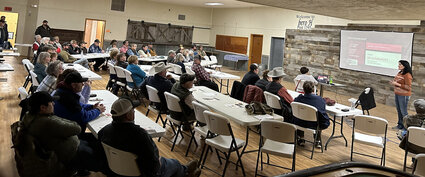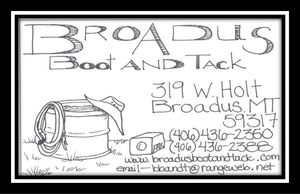Highway 212 Safety Action Plan Garners Public Input
February 29, 2024
On Wednesday, February 21st, a meeting to gather public comment for the Hwy 212 Safety Action Plan was held at the VFW in Broadus.
60 members of the community along Highway 212 attended the meeting, consisting of folks stretching from Carter County, many individuals from Powder River County, and on west to members of the Northern Cheyenne Tribe.
Julie Emmons, Community Development Coordinator for Southeast Montana Development Corporation, led the event, along with Angela Mendoza, SEMDC Grant Administrator/ Public Relations Coordinator.
The meeting began with a video and slide show demonstrating the purpose of the project, which is to identify hazards and solutions along the Highway 212 corridor in SE Montana.
Emmons described how the end goal was to use the project to secure funding through the recent federal infrastructure bill, which may be used for larger projects along the route. So far this is the only highway project in the state that has been looking into funding in this manner.
The timeline of the project is as follows: currently the group is engaged in outreach with the public, following data analysis and mapping. In late spring and summer the "solutions development" phase will take place, as well as another round of input from the public on the potential solutions, followed by a draft report in late summer. By early fall the final 212 corridor action plan is expected to be complete. Julie noted that funding and eventual implantation of larger scale projects would likely be several years down the road.
Analysis
The slide show shared some sobering statistics put together by partner firm KLJ Engineering from Billings.
The highest number of collisions along the route by county between 2013 and 2022 has been in Powder River County, with 259 of the 611 along the route, in the four counties in which Hwy 212 runs between Crow Agency and the Wyoming line.
129 of those 611 crashes have been rollovers, according to the slide show, with the second highest collision numbers (104) coming as a result of hitting a fixed object (such as a guard rail). The third highest, with 82, was wild animal collisions.
Out of those numbers, 839 total vehicles were involved, with 350 involving commercial vehicles.
51 fatalities occurred out of those incidents. The highest cause of fatalities came from head on collisions, with 14, and 10 from rollovers.
A speed analysis showed that the 85th percentile of traffic along the entirety of the route between towns (that is, the speed at which 85 per cent or more of traffic traveled) was 77 mph. That data was collected for speeds measured in 2022, with the 65 mile per hour speed limit in operation. The change to the special speed zone occurred in the fall of 2019.
Truck speed analysis during this same time indicated a 68 mile per hour 85th percentile speed through the 65 mph zone.
Steve Grabill with KLJ Engineering noted in an email that the speed analysis uses a combination of data sources, from connected vehicles, GPS sources, third-party applications, and census data.
Potential Problems
Comments at the meeting were many and varied. One point brought up was regarding the need for passing lanes and wider shoulders along the route.
Numerous comments centered around truck drivers on 212, with conversations ranging from speeding trucks to communication issues with non-english speaking commercial drivers, to whether the 65 mph speed for all has helped or hindered the flow of traffic.
Another issue is that of built-in GPS systems in vehicles, which oftentimes show the speed on Highway 212 to be 70 mph.
Emmons-Stoddard commented that of the 27 highway patrol positions in this side of the state, 15 positions are currently open, meaning law enforcement manning is an issue.
In speaking with PR County Justice of the Peace Cathy Landa following the meeting, we learned that their office has seen a steady increase in traffic tickets over the years, to the tune of around an additional 100 to 200 per year, in her 18 years in office. As traffic has picked up over the years, so have tickets. A research project in 2023 found that since the year 2000, vehicle travel on Montana's roads has increased 35%, as the state's population burgeoned 24%.
Potential Solutions
Julie noted that their plan had three goals in mind when it came to looking at ways to fix potential traffic issues as the safety action plan becomes implemented: Education, Engineering, and Enforcement.
Forms of education could include additional electronic signs showing the driver's speed (like those currently emplaced at Broadus, and working with Wyoming and South Dakota on the sections of Hwy 212 through their states, potentially closing the road further east when the weather is bad. Other forms of education would be to use signs that help commercial drivers who have a language barrier to ensure they understand the signs, using more pictrogam oriented signs versus text oriented signs that rely on language.
Engineering might take the form of improved shoulders on the roads to help prevent rollovers in the case of vehicles leaving the road, or passing lanes at certain spots along the route (passing lanes were a hot topic of conversation at the meeting).
These major projects would likely be years in the making between planning, funding, engineering, and construction, and cost significant amounts of money.
Wider, better roads could also cause a potential issue: the concept of induced demand.
In practical terms, induced demand is the idea that if you build better roads with more lanes, traffic increases. The concept has been studied across the United States and consists of a complex set of social and engineering factors that basically boils down to this: better roads means more drivers. That concept applies to the tourist or truck driver coming through Broadus who now takes 212 instead of the interstate, or to the local who now follows their kids to every away junior high sports game because it's a lot quicker trip than it was in years past when the roads were harder to navigate.
The third potential solution: Enforcement. Potential solutions here might include working with Montana Highway Patrol to find solutions to hire more officers in Eastern Montana.
If you have your own ideas on problems and options for Highway 212 safety, the Safety Action Plan would love to hear from you. Those looking to provide written comments may mail them to US Hwy 212 Safety Project, PO Box 430 in Broadus, or email to julie@semdc. org.
An interactive map is available online where users may "drop a pin" on areas of concern along the Hwy 212 map, which is useful in showing particular trouble areas along the route. A survey for Hwy 212 users is also available. That site is:
Additional public comment meetings are scheduled in Lame Deer (we had not heard back on a date or time as of press time), and a meeting in Ashland is tentatively scheduled for March 9th.









Reader Comments(0)